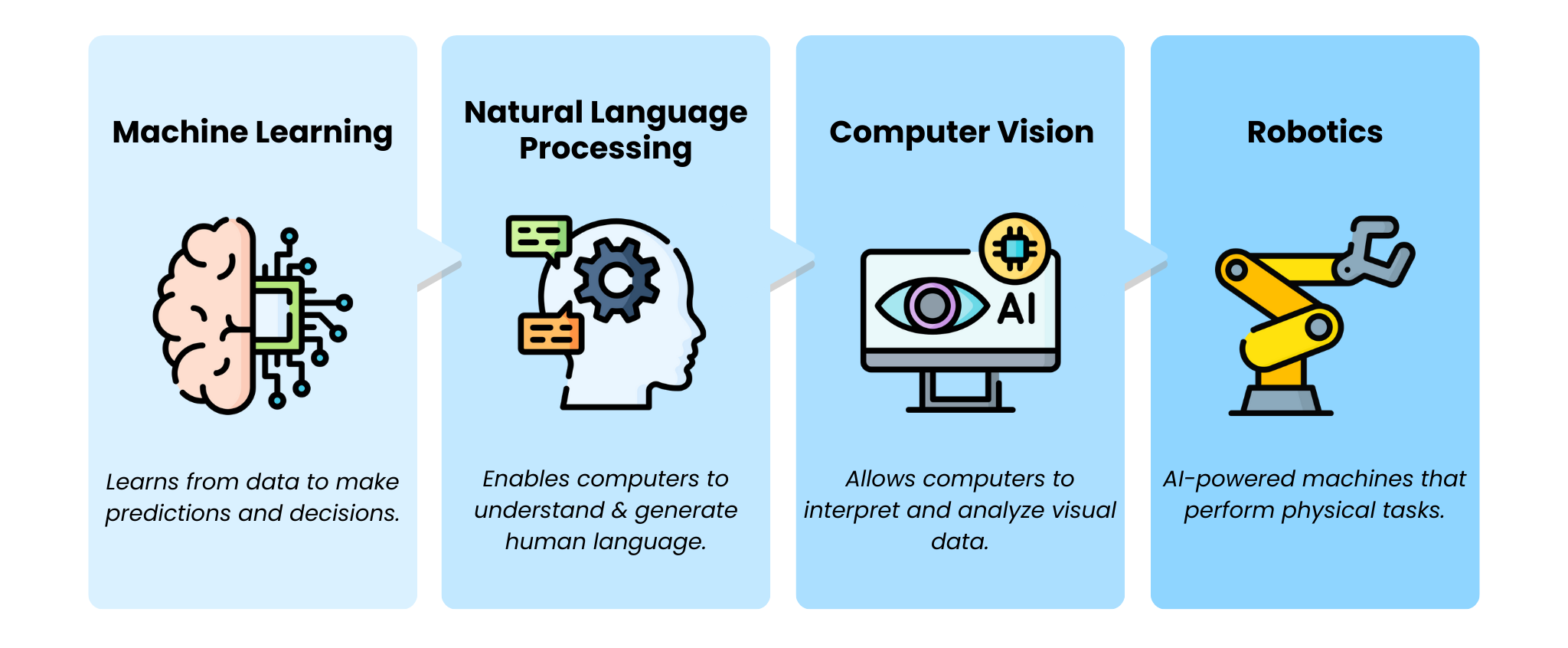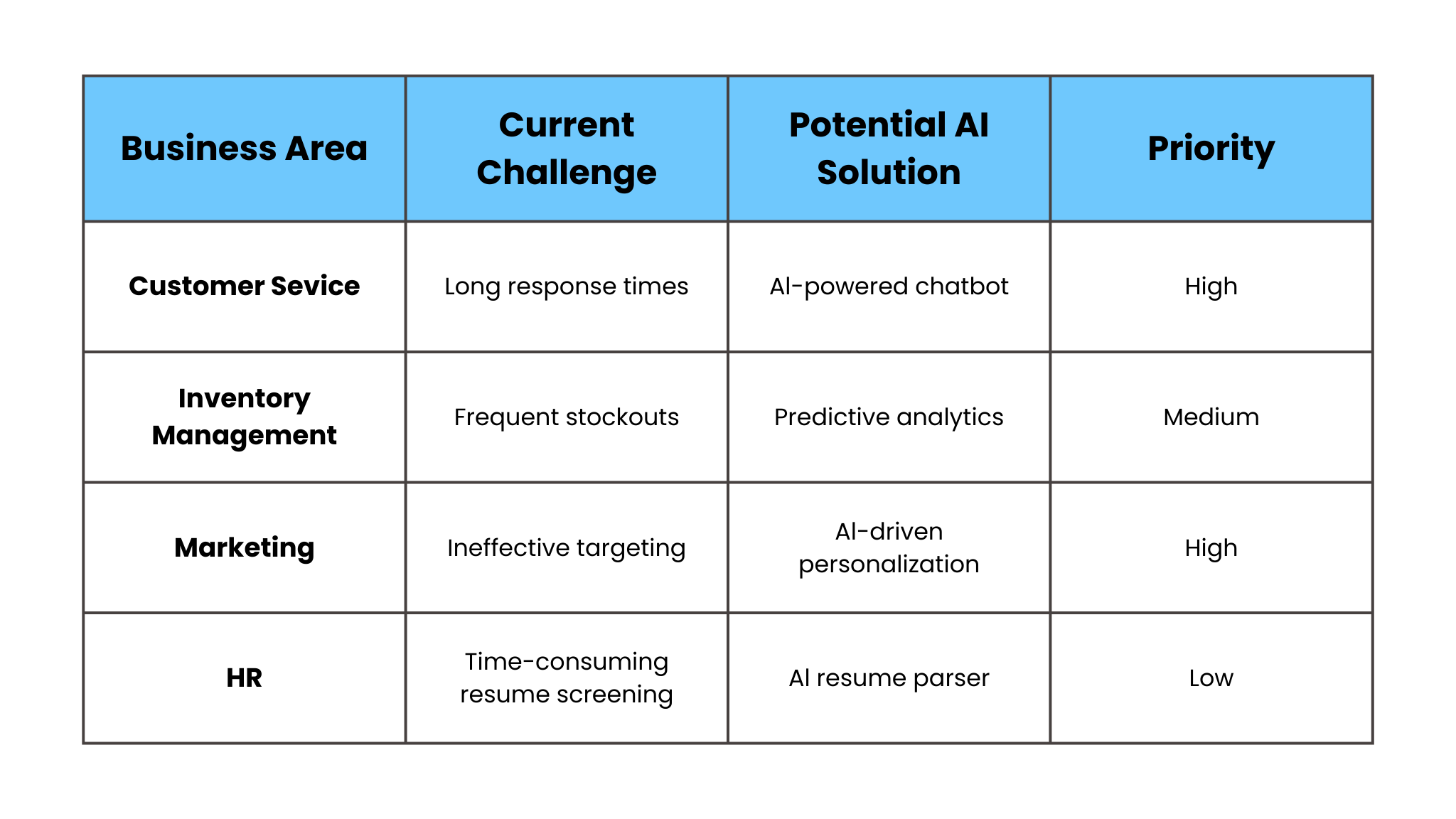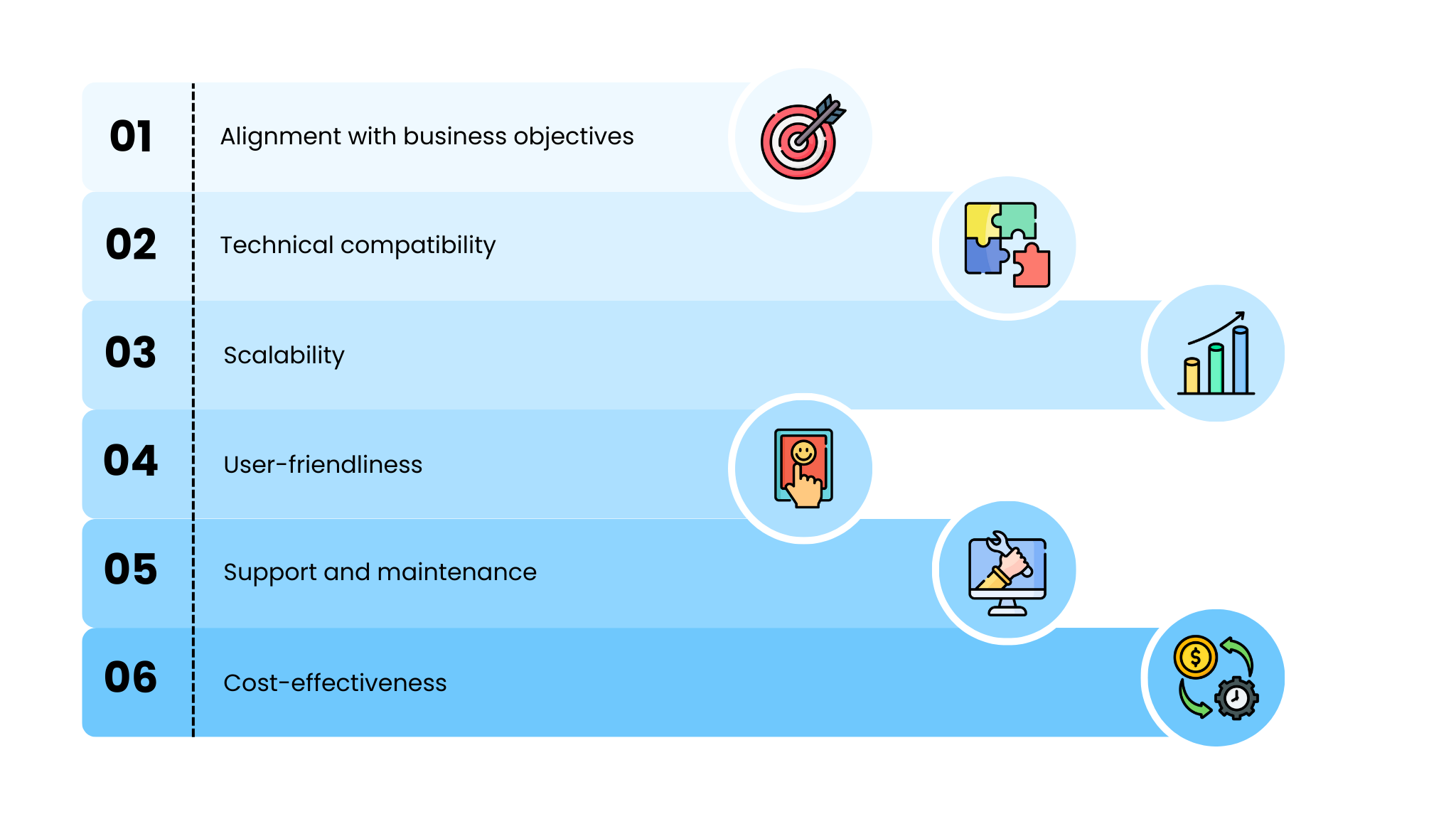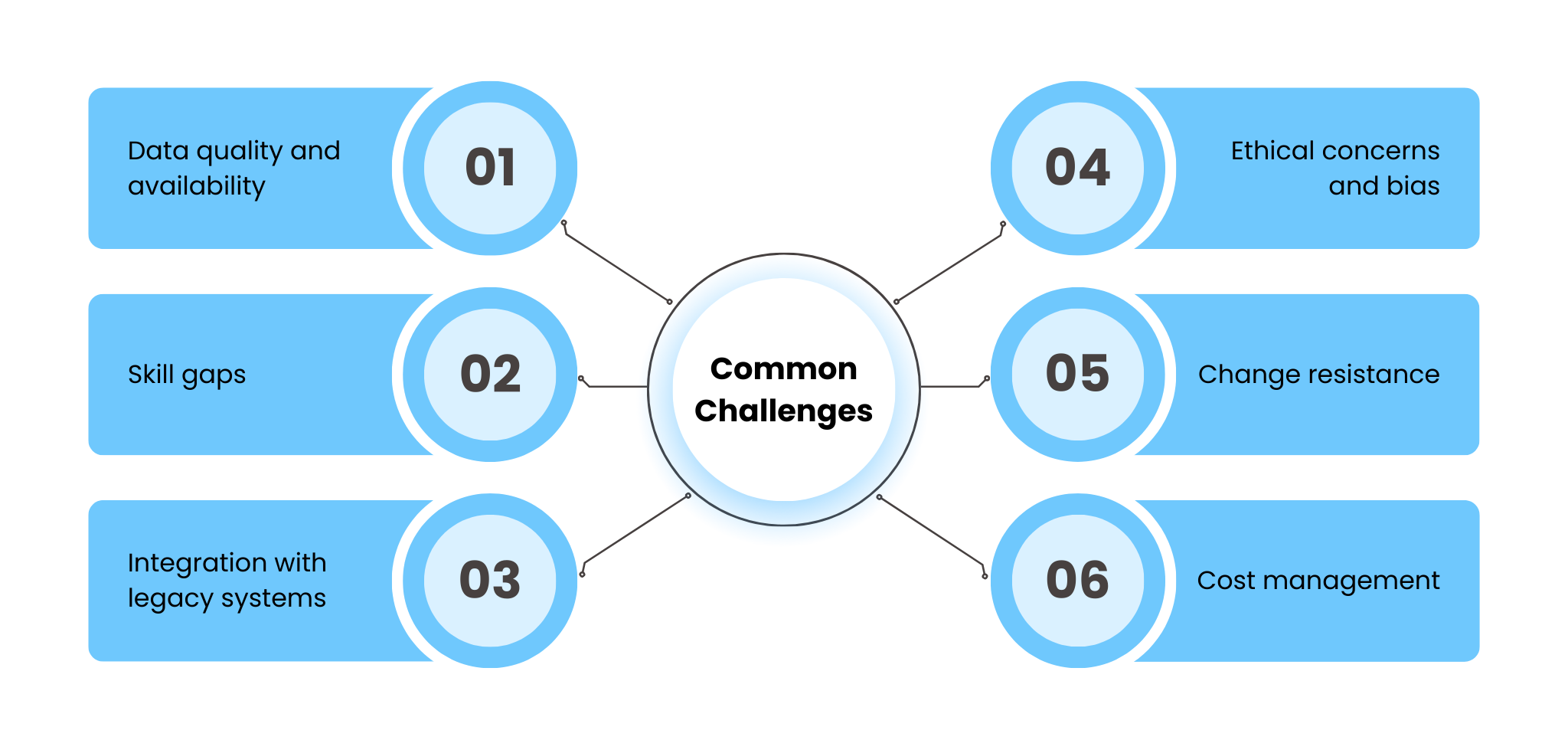How to Implement AI Solutions in Your Business
Nearly half (42%) of companies are already exploring AI, and over half (50%) plan to jump on board this year. With the window to gain a competitive advantage through AI rapidly closing, it’s crucial for your business to start exploring AI solutions or risk falling behind.
AI has come a long way from its early days in research labs. Today, it’s a rapidly evolving field offering a wealth of practical applications for businesses. In this guide, we’ll bridge the gap and walk you through the ins and outs of implementing AI solutions, from understanding the basics to overcoming common challenges.
So, let’s empower your business for the future!
Understanding AI Solutions for Your Business
Before starting the implementation process, it’s crucial to understand what AI solutions can offer your business. AI refers to computer programs designed to do tasks that traditionally require human cognitive abilities. These abilities include learning, problem-solving, and decision-making.
AI solutions can automate operations, analyze large amounts of data to generate useful strategic insights.
Some common types of AI solutions for businesses include:

- Machine Learning (ML): Algorithms study data, learn from it, and use that knowledge to make predictions or decisions.
- Natural Language Processing (NLP): Systems understand and generate human language, enabling natural communication, text processing, and tasks like translation or sentiment analysis.
- Computer Vision: AI technology allows computers to “see” and understand the world by analyzing and interpreting visual information.
- Robotics: AI-powered machines perform physical tasks in the real world, programmed to move, manipulate objects, and interact with their environment.
Implementing AI solutions in your business can significantly impact your bottom line. It automates routine tasks, freeing employees for strategic work and boosting productivity and job satisfaction. This translates into a more engaged workforce and fuels further efficiency gains.
The power of AI extends beyond internal operations. AI-powered analytics offer in-depth insights into customer behavior, market trends, and operational efficiency, empowering you to make data-driven decisions that enhance customer experiences. This can be accomplished through personalized recommendations and 24/7 chatbot support, ensuring your customers feel valued and supported at every touchpoint.
Guide to Implement AI Solutions in Your Business
Step 1: Assessing Your Business Needs
Implementing AI solutions begins with identifying areas where AI can have the most significant impact. This process involves analyzing your current operations, pain points, and strategic goals.
Start by doing a thorough audit of your business processes. Pay close attention to tasks that are time-consuming, repetitive, or prone to human error. These tasks are often prime candidates for AI automation.
Next, engage with employees across different departments. Gather insights on their day-to-day challenges and areas where AI could benefit them. This step helps identify potential AI applications and fosters buy-in from staff working with these new technologies.
After gathering insights, prioritize the identified areas for AI implementation. Consider factors such as potential ROI, ease of implementation, and alignment with your overall business strategy.
To help visualize this process, consider creating a table like the one below:

Step 2: Building a Strong Foundation
Before implementing AI solutions, lay a solid foundation for success. This involves preparing your data, infrastructure, and workforce.
First, ensure your data is ready. AI systems rely on high-quality, well-organized data. Start by assessing your current data practices. Identify any gaps or inconsistencies that must be addressed.
Next, implement robust data governance policies to ensure data accuracy, completeness, and accessibility. This may involve centralizing data from various sources and standardizing data formats. Establish clear protocols for data management.
Consider investing in a data infrastructure that can handle the volume and velocity required for AI applications. Options include cloud-based storage solutions or data lakes.
Equally important is preparing your workforce for AI integration. Develop AI literacy across your organization, from leadership to front-line employees. Provide training and educational resources on the basics of AI and its potential applications. Explain how AI will impact their roles. Encourage employees to adopt new technology to promote an environment that values creativity and ongoing learning.
Another crucial step is creating a cross-functional AI implementation team. This team should include representatives from IT, data science, business operations, and departments impacted by AI. By bringing together different viewpoints and experiences, you can approach AI integration holistically, considering technical, operational, and strategic factors.
Remember, as Elon Musk said, “The first step is to establish that something is possible; then probability will occur.” By building a strong foundation, you set the stage for successful AI integration in your business.
Step 3: Selecting the Right AI Solutions
With a strong foundation, the next step is to select the right AI solutions for your business. This process involves researching options, evaluating suitability, and conducting proof of concept (PoC) projects.
Start by exploring both off-the-shelf AI products and custom solutions. Consider the following: functionality, scalability, integration capabilities, and cost
When evaluating AI solutions, it’s important to consider the following criteria:

- Alignment with business objectives: Does the solution address your identified pain points and support your strategic goals?
- Technical compatibility: Can the solution integrate seamlessly with your existing systems and infrastructure?
- Scalability: Can the solution grow and adapt as your business needs to evolve?
- User-friendliness: Is the solution intuitive and easy for your employees to use?
- Support and maintenance: What level of ongoing support and maintenance does the vendor provide?
- Cost-effectiveness: Does the potential ROI justify the investment in the solution?
After evaluating potential AI solutions, move on to conducting PoC projects. These small-scale pilots test the solutions’ performance in your specific business context. PoC projects allow you to assess the solution’s effectiveness and identify any implementation challenges.
Gather feedback from users during these pilots to refine your understanding of the impact of the solution. This feedback is crucial before committing to a full-scale rollout.
Finally, use the results of these PoC projects to inform your final decision. This ensures you choose the most effective AI solutions for your business needs, providing a solid foundation for successful implementation.
Step 4: Implementing AI Solutions
With the right AI solutions selected, it’s time to implement. This phase requires careful planning, effective change management, and close collaboration with solution providers.
First, develop a detailed implementation roadmap outlining the steps, timelines, and resources needed for each rollout phase. Be sure to include milestones for system integration, data migration, user training, and performance evaluation.
Next, focus on integrating AI solutions with your existing systems. Work closely with your IT team and solution providers to ensure seamless data flow. This may involve developing custom APIs, updating legacy systems, or implementing middleware solutions to facilitate platform communication.
Effective change management is also crucial for successful AI implementation. Clearly and often inform employees of the upcoming adjustments. Explain the benefits of AI integration and how it will impact their roles.
Then, comprehensive training will be provided to ensure staff are comfortable using the new AI tools. Help them understand how to interpret and act on AI-generated insights. Consider appointing AI champions within each department to support and encourage adoption.
As you roll out AI solutions, closely monitor their performance and impact on your business operations. Establish key performance indicators (KPIs) to measure effectiveness.
Important KPIs include:
- Productivity gains
- Cost savings
- Customer satisfaction improvements
- Revenue growth
Review these metrics regularly and gather user feedback to identify any issues or areas for improvement. Be prepared to adjust your implementation strategy based on these insights, as AI integration is an iterative process that requires ongoing refinement.
Step 5: Monitoring and Optimizing
Implementing AI solutions in your business is an ongoing process of monitoring, learning, and optimization. As your AI systems process more data and interact with users, they will continue to learn and improve their performance. However, this process requires active management and regular fine-tuning.
To begin, establish a system for continuous monitoring of your AI solutions. Track key metrics such as accuracy, efficiency, and user satisfaction. Use this data to identify areas where the AI can be improved or expanded. For example, if your customer service chatbot struggles with certain inquiries, it may need additional training data.
Next, regularly review the impact of your AI solutions on overall business performance. Are they delivering the expected ROI? Are there unexpected benefits or challenges? Use these insights to inform your ongoing AI strategy and identify new opportunities for AI implementation.
As your AI solutions mature, look for opportunities to scale their use across your organization. This might involve expanding a successful AI application to other departments. Additionally, leverage insights from one AI system to inform the development of new solutions.
By continuously monitoring, optimizing, and expanding your AI implementations, you can ensure your business remains at the forefront of AI innovation. This approach ensures that your business continues to benefit from these powerful technologies.
Overcoming Common Challenges
Integrating AI solutions in your business can bring significant benefits, but it’s not without challenges. Being aware of these possible difficulties and having solutions to overcome them is vital for successful AI integration.
Here are some common challenges and strategies to address them:

- Data quality and availability: Ensure you have robust data collection and management practices in place. Additionally, invest in data cleaning and enrichment tools if necessary.
- Skill gaps: Provide ongoing training for employees and, if needed, consider partnering with AI experts or consultants to fill immediate skill gaps.
- Integration with legacy systems: Develop a phased approach to modernizing your IT infrastructure, initially focusing on critical integrations.
- Ethical concerns and bias: Implement ethical AI guidelines and make it a practice to regularly audit your AI systems for bias. Moreover, ensure diverse representation in your AI development teams.
- Change resistance: Create an environment that values creativity and ongoing education. To facilitate this, clearly communicate the benefits of AI and engage employees in the implementation process.
- Cost management: Start with small-scale implementations and always prioritize projects with clear ROI. Furthermore, cloud-based AI solutions should be considered to reduce upfront infrastructure costs.
By anticipating these challenges and adopting these proactive strategies, you can smooth the path to successful AI integration in your business.
Successful AI Implementations Case Studies
The following case studies highlight unique AI implementations and their specific outcomes, demonstrating AI’s transformative potential across different industries.
Case Study 1:
Coca-Cola Implements AI for Inventory Management
Coca-Cola faced a challenge with inefficient inventory management, leading to frequent stockouts and overstock situations. To address this, they implemented an AI-powered inventory management system.
The AI system analyzed historical sales data, market trends, and various external factors. By predicting demand accurately, it optimized Coca-Cola’s inventory levels. This meant the company could foresee when and in what quantities products would be needed.
The results spoke for themselves. Stockouts decreased drastically, ensuring customers always found their favorite Coca-Cola products on the shelves. Overstock issues were also reduced, cutting down storage costs and waste. This newfound efficiency allowed the company to allocate resources more effectively.
In essence, Coca-Cola’s AI implementation delivered a trifecta of benefits:
- Increased sales due to consistent product availability
- Reduced costs from lower storage needs
- Enhanced customer satisfaction with fewer stockouts
The impact on Coca-Cola’s operations was profound. The AI-driven solution streamlined processes and boosted overall efficiency. This transformation significantly improved their supply chain performance. Coca-Cola saw inventory levels and holding costs reduce by 20-50% and shipping costs decrease by 15-30%.
Case Study 2:
Danske Bank Leverages AI to Combat Fraud
Danske Bank faced significant challenges with detecting and preventing fraud. Traditional methods were insufficient in addressing sophisticated fraudulent activities. To tackle this issue, the bank implemented an AI-driven fraud detection system.
The AI system analyzed transaction data, identifying patterns and anomalies indicative of fraud. It used machine learning algorithms to improve detection accuracy over time. This enabled Danske Bank to proactively identify and prevent fraudulent transactions, leading to a series of positive outcomes.
- Enhanced fraud detection accuracy by 50%
- Reduction in false positives, minimizing customer inconvenience
- Improved operational efficiency with real-time monitoring
The impact on Danske Bank was substantial. The AI-driven solution not only enhanced their ability to combat fraud but also improved customer trust and satisfaction. The bank saw a major decrease in fraudulent activities, which protected both the bank and its clients from financial damage.
Case Study 3:
Airbus Elevates Aircraft Maintenance with AI-Powered Predictive Maintenance
Airbus faced a significant challenge in ensuring flight safety and operational efficiency by predicting maintenance needs. The goal was to prevent equipment failures and reduce downtime, a critical issue in the aviation industry.
To address this, Airbus implemented an AI system for predictive maintenance. This system analyzed data from aircraft sensors, historical maintenance records, and operational data. By identifying patterns that indicated potential issues, the AI could predict when maintenance was needed. This shift from reactive to predictive maintenance allowed Airbus to enhance safety and optimize maintenance schedules.
The results were impressive. Airbus reduced maintenance costs and aircraft downtime significantly. The proactive approach improved overall safety and operational efficiency. Specifically, they saw:
- Maintenance costs reduced
- Aircraft downtime minimized
- Enhanced safety with proactive maintenance
This highlights the transformative impact of AI solutions in aviation. By aligning AI technologies with their specific needs, Airbus achieved substantial improvements in efficiency, cost savings, and safety.
Optimizing Your Business for the Future with AI
Implementing AI solutions in your business requires careful planning, execution, and ongoing optimization. By following the steps in this guide, you can integrate AI successfully. Start by assessing your needs, building a strong foundation, and selecting the right AI solutions. Then, implement and monitor these solutions to reap the benefits of this transformative technology.
Remember, AI implementation is not a one-size-fits-all process. Each business has unique needs, challenges, and opportunities with AI integration. Stay flexible, be willing to learn and adapt, and focus on how AI can help achieve your strategic objectives.
As you start your AI journey, keep in mind that technology is continually improving. Stay informed about new AI developments and be ready to adjust your strategy as new opportunities arise. With the right approach, AI can drive innovation, enhance efficiency, and create new competitive advantages in an increasingly digital world.




